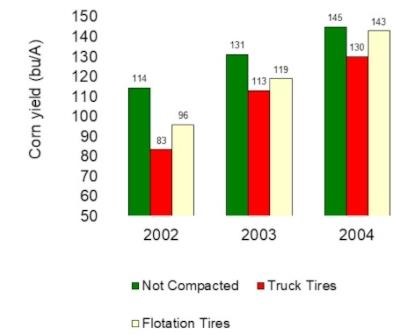By Sjoerd Willem Duiker
Soil compaction continues to be a threat this fall because of high soil moisture content. Field work is in high gear with corn silage being wrapped up, manure being spread, and corn and soybean harvest underway. Several years ago, we did a study in continuous no-till where the entire soil surface was compacted in spring during damp conditions with one pass of a loaded, 30-ton manure truck mounted with road tires inflated to 90-100 psi. Corn yield reductions were 27% in a dry year, and 14% and 10%, respectively, in years with more favorable moisture conditions (see Figure 1).

LSW tires on tractor are one way to increase the footprint and run low tire pressure while still carrying the load. This tractor was showcased at Penn State’s recent Field Crop Clinic in Landisville. Image Credit: Andy Jackson, Skyblu Farms
This shows that root growth reduction due to compaction makes the crop more susceptible to drought because it explores a smaller volume of soil for moisture. By using wide tires inflated to 35psi the damage was reduced by half. Today, there are tires that can be run at lower pressures while still being able to carry the load. Lower tire pressure results in less surface compaction. Farmers should check with their equipment dealers to determine what is the appropriate tire pressure to run in their tractor, combine, grain cart, and manure spreader tires. Lower pressure = less compaction.

Figure 1. Corn yield in continuous no-till as affected by soil compaction with a 30-ton manure truck mounted with either road tires inflated to 100 psi or wide tires inflated to 35 psi.
Source : psu.edu